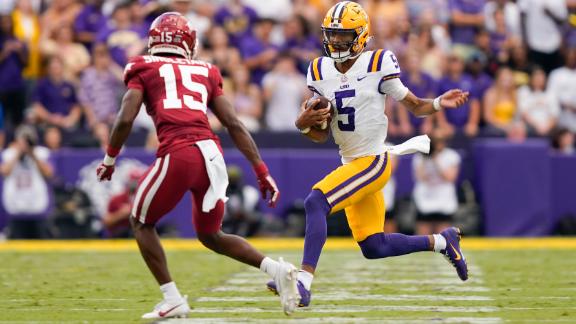Arkansas looked much better than the team that lost to BYU, but a loss is still a loss, and penalties and baffling game management cost the Hogs a shot at a major road upset.
There were plenty of positives from the loss, as Arkansas’ defense was excellent for the first 29 minutes, and the offense had its best outing of the season. LSU almost certainly has the SEC’s best offense and may be the SEC West favorites due to Alabama’s offensive issues, so the Hogs can build on this performance.
- Box Score Breakdown: Texas Tech 85, Arkansas 83
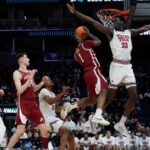
- Matchup Analysis: 3 Texas Tech

- Box Score Breakdown: Arkansas 75, St. John’s 66

Advanced Stats

For the second straight game, penalties were extremely costly, but this time, the Hogs only lost a net of minus-2.1 points on them, so they aren’t responsible for the final margin of defeat. This was Arkansas’ best offensive game – yes, better even than the Western Carolina game – as the Hogs totaled +17.2 EPA on offensive plays. Unfortunately, this was Arkansas’ first defensive game in the negative, and it was a whopper: LSU totaled +22.9 EPA on its offensive snaps.
Arkansas made up some of the distance with special teams (the fake field goal plus a good punt from Max Fletcher) and placekicking (3 of 3 on field goals), but it wasn’t quite enough.

Our models say that this game was not as close as a final score indicated. Noise-adjusted points turns down the impact of high-leverage, unpredictable, or otherwise chaotic plays that are unlikely to repeat. Essentially, Arkansas didn’t play amazing on offense, and they were fairly lucky to get to 31 points, given that they allowed 13 negative plays and converted several third-and-longs just to stay in the game.
Unfortunately, noise-adjusted points are more predictive of future performance than actual points, so unless the Hogs fix the major issues with the offensive tackles and general lack of discipline, the offense is unlikely to be as productive as it was on Saturday.

LSU averaged 9.2 yards per play, had just four negative plays, gained 75% of available yards, and didn’t turn it over. The only reason they finished with 34 points is because each team got just nine drives: play this game at the pace of last week’s BYU game and LSU easily scores 50.
But the slow pace was part of Arkansas’ strategy. That’s what a Dan Enos offense can do for you if it works right. Arkansas’ offense still has a ton of issues, but the topline production was vintage Enos: the Hogs had just one three-and-out (on the opening drive) averaged a staggering 7.4 plays per drive. That limited LSU to just nine drives and an average starting field position of their own 24. The offense (and special teams) did all it could to help out the defense. The good news is LSU has the best offense Arkansas will face this season.

This was a defensive coordinator’s nightmare, as both offenses were incredible in must-pass situations. The main difference is that LSU was also good on early downs, which made their drives much smoother. Leverage rate is the percentage of an offense’s plays where they are “on-schedule”; that is, not behind the chains, and LSU won that, 82% to 75%.

LSU’s run defense might be suspect, but the Hogs were pretty efficient on the ground. They were able to take some of the pressure off of KJ Jefferson with some good early-down running.
LSU, on the other hand, lit the Hogs up on the ground, though that was mostly a function of their passing game being so good. Opponents basically have to ignore the LSU run game in order to try and stop the pass, and this is what happens.

Jayden Daniels was incredible, but for Jefferson to be able to match him with this offensive line was an impressive feat. Jefferson spent a lot of this game making something out of nothing.

Luke Hasz is so good: 7 targets, 6 catches, 116 yards, two touchdowns, +10.5 EPA, game-best +70% win probability added (!), and 71% success rate (5 of his 7 targets were successful).
The Hogs also went with Rashod Dubinion over AJ Green in the backfield. Green was much better than Dubinion last year and was better in the Kent State game, but Enos and staff made some changes to the run game that better suited Dubinion.
Green is a better zone runner: he has superior vision and is much quicker in his first few steps. Dubinion misses holes in the zone running scheme and lacks a quick first step. However, Dubinion is a more physical runner and a true tackle-breaking machine. Heading into this game, Dubinion had 15 broken tackles in 27 carries: that’s a 60% broken tackle rate! However, because of his lack of quickness and vision, most of those broken tackles happened right at the line of scrimmage, and he was averaging just 0.7 yards before contact per rush (compared to 2.5 for Green).
In this game, the Hogs really focused on running right up the middle, following their best run blockers and playing to strength of their powerful tailback. Most of the best runs were inside zone, which was the bread-and-butter of Kendal Briles’ run game but hasn’t been heavily featured so far under Enos.
First, Arkansas’ most productive run last year, the Bluff Read, where a motion man gives some eye candy for the inside zone:
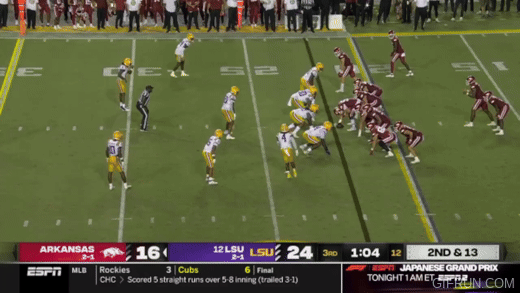
In a Split Zone, the h-back crosses the formation but blocks the backside edge, preventing him from blowing up the play:
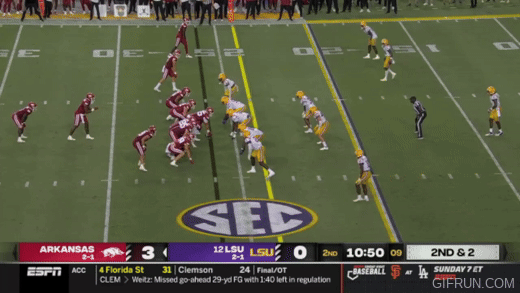
We also saw plenty of this run’s complement, the Insert, a form of inside zone where instead of blocking the backside end like Hasz does above, that mean is read and the h-back breaks inside to act as a lead blocker:
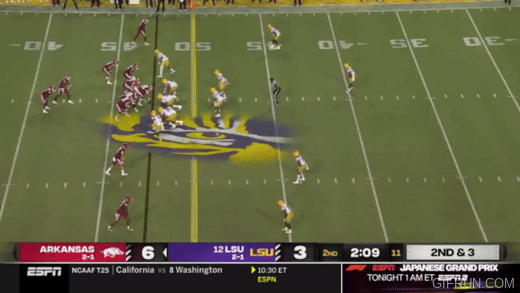
Obviously, both of these runs have holes that we haven’t seen much of this year, but also note at the end of that second run that Dubinion was first contacted at the 42 and he doesn’t go down until the 37. That’s five yards after contact in addition to the well-blocked run. Rocket Sanders and AJ Green don’t give you that ability to ping-pong down the field for extra yards. Those guys may hit a wide-open hole better, but Dubinion just keeps chugging north and south.
It wasn’t all inside zone: the Hogs also run some gap-schemed stuff, like this excellent GT Power Read where Dubinion racks up more YAC:
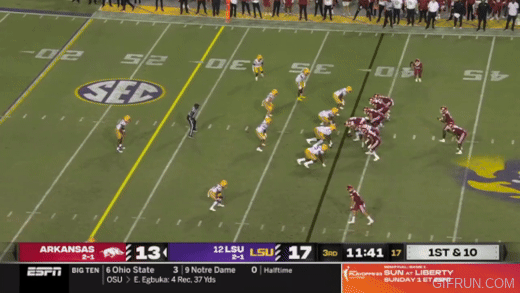
While the run game was definitely much better, the Hogs appear to be limited in what they can try. Green got three carries – none of them inside zone – and they all went for no gain. In this game, the run was a nice complement to the pass game. That’s what it will have to be. The Hogs ran more play action and more RPOs and looked like an offense with a stronger identity. There were still a few too many negative plays and too many penalties – that’s mostly the line’s fault – but the progress is there.
Up Next
Texas A&M looks very beatable, despite a 27-10 win over Auburn. The Aggies are talented but inconsistent on defense, and may have to start Max Johnson at quarterback after Conner Weigman was injured. The Aggies opened as 6.5-point favorites in Arlington.
Thanks for reading! Be sure to follow us on Twitter and on Facebook.
The latest from Fayette Villains, straight to your inbox
Enter your email to subscribe and receive new post alerts and other updates. You can unsubscribe at any time.
